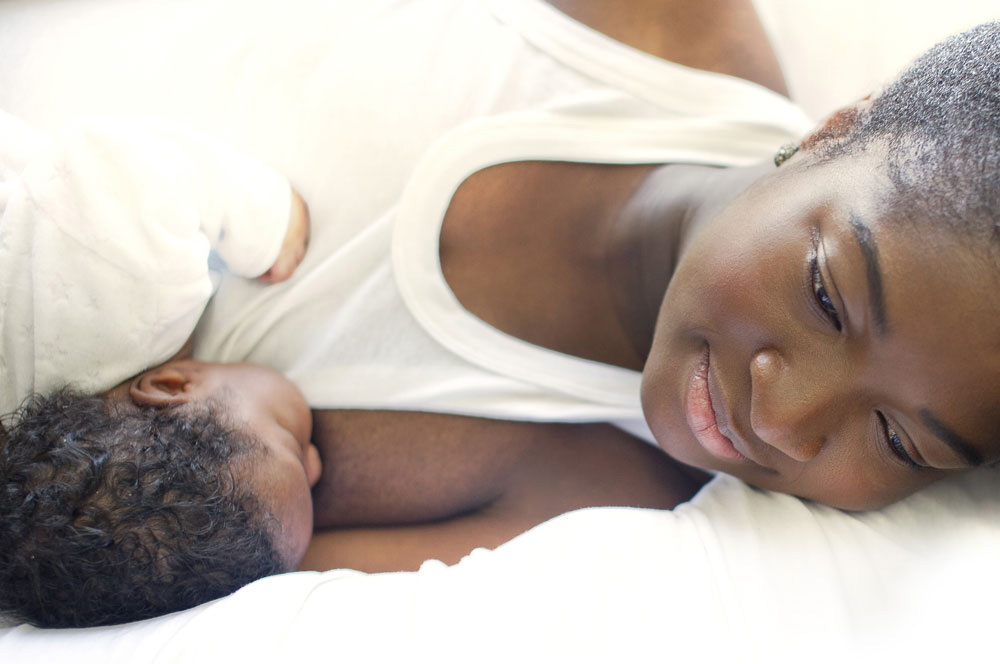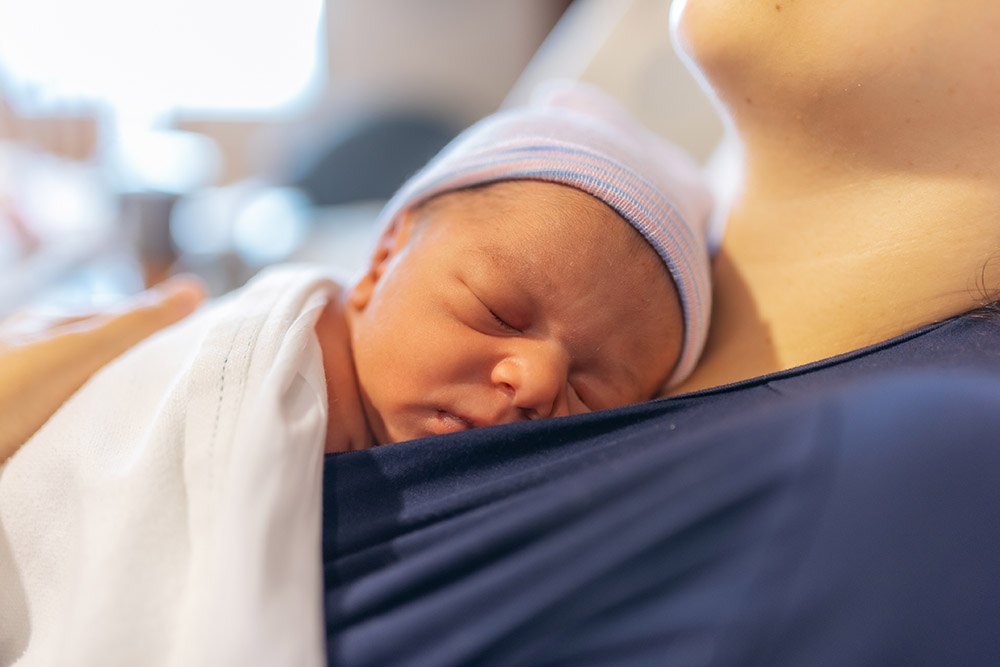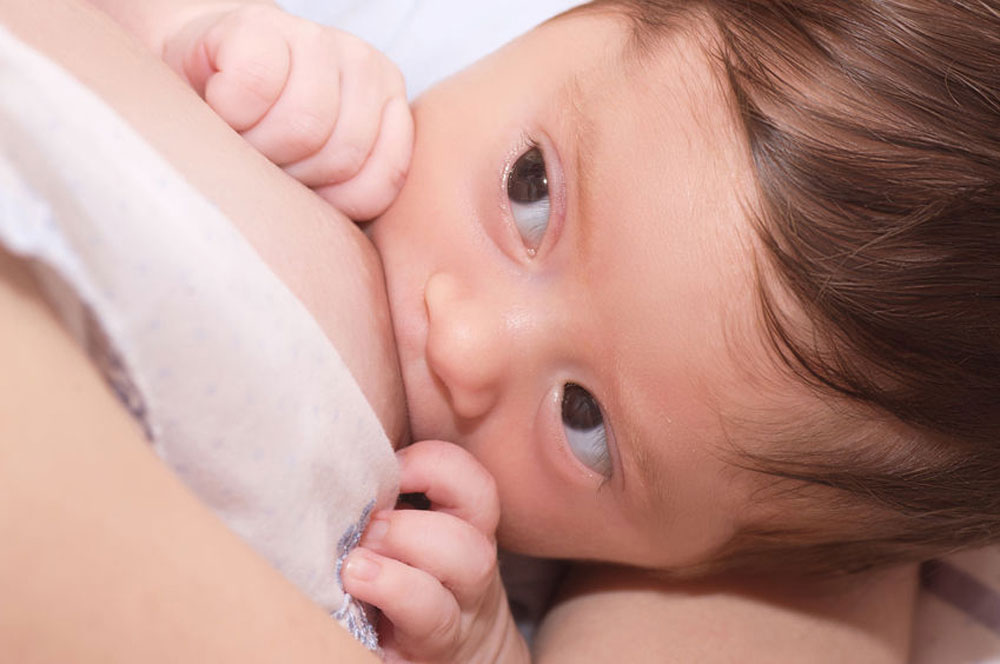A mother may sometimes notice blisters or white spots on her nipples during breastfeeding. Friction blisters and blocked nipple pores (milk blisters or blebs) are the most common causes. This article discusses the types of blisters or white spots on nipples that a breastfeeding mother may encounter and gives ideas to avoid or resolve them. Contacting your health professional will help confirm the cause of the white spot or blister if you are not sure.

Friction blisters
A clear blister or red/brown “blood blister” on the nipple is usually caused by friction or high vacuum just like a blister anywhere else on the body. Possible reasons for friction blisters on nipples include:
- A shallow latch. If a baby is not attached (latched) deeply on the breast with plenty of breast tissue in their mouth as well as the nipple it is called a “shallow latch”. If a baby is in a shallow latch, there is more chance for the mother’s nipple to rub against the roof of her baby’s mouth and cause a blister at the point of contact. See our articles Breastfeeding Positions for Newborns and Latching Tips for help to improve your baby’s positioning and attachment, or find a breastfeeding expert to help you.
- A poorly fitted nipple shield or pump flange. Blisters on nipples may be caused by a badly fitted nipple shield or pump. For information about getting a good fit on a pump flange see How to Increase Milk Supply When Pumping and the Flange FITS™ Guide from Babies in Common. For more information about choosing a nipple shield see Nipple Shields Good or Bad?
- Differences in anatomy preventing a deep latch. Individual anatomy such as a larger nipple, flat nipple or a baby with a small mouth or restricted tongue function could make it more difficult for a baby to get a deeper more comfortable latch and blisters may be more likely. Careful positioning can help with these issues.
Once the source of the friction has been found and corrected, blisters should quickly heal on their own. If a blister bursts before it has healed beneath and you have sore broken skin on your nipple check out Treatments for Sore Nipples.

Milk blisters or blebs
If inflamed tissue, thickened milk or a thin layer of skin blocks one (or more) of the openings of the nipple (nipple pores), it may cause a white or yellow spot on the nipple. This is often called a bleb or milk blister. A bleb that doesn’t hurt may disappear on its own in a few weeks or months. However, if the bleb is stopping milk flow from the affected nipple pore, it may cause severe pinpoint pain during breastfeeding.1 A blocked nipple pore can be associated with a blocked milk duct behind it which could lead to breast inflammation such as engorgement or mastitis.2
What causes a bleb or milk blister?
There are several different theories for the causes of blebs. Most authors agree that they are associated with inflammation of the nipple skin around the nipple pore.3456 However more research is needed to identify the exact cause of the inflammation. Theories include:
- Mechanical trauma. Douglas (Douglas, Vol 18: 1–29 2022) and Walker7 consider the most likely explanation for blebs to be an inflammatory reaction due to mechanical trauma to the nipple (suboptimal latch and positioning). The wound healing due to inflammation may block a nipple pore with a layer of skin; causing milk to build up behind it creating a milk blister. Along similar lines, Wambach and Spencer propose a bleb is an inflammatory response to milk in a nipple pore sealed over by skin (Wambach and Spencer, 2021. p 295).
- Pressure cyst. Authors Lawrence and Lawrence suggest a bleb could be a small pressure cyst at the end of a milk duct created due to milk seeping into the elastic tissue.(Lawrence, 2016, p270).
- Subacute mastitis or mammary dysbiosis, milk consistency or hyperlactation. Mitchell and colleagues propose that subacute mastitis or mammary dysbiosis (an altered microbiome in the breast), fattier milk or hyperlactation (when the body produces more milk than a baby needs) could all be possible causes of bleb formation89 One case report described a mother thought to have subacute mastitis associated with nipple blebs and persistent blocked ducts. The mother’s milk tested positive for MRSA (methicillin-resistant Staphylococcus aureus) and treatment for an MRSA infection resolved all issues (Mitchell, English and Bamberger, 2020). However, Douglas finds the theoretical connection between subacute mastitis or mammary dysbiosis with bleb formation unconvincing (Douglas, Vol 18: 1–29 2022).
Ideas to treat a bleb
There are a number of ideas to reduce the inflammation around a bleb, provide pain relief and prevent infection. Since experts have different theories for the cause of a bleb, there are different ideas for treatment eg some clinicians might focus on removing the plug while others consider its original cause. Some ideas may require the help of a health professional and some can be tried at home. If the bleb is physically released, little granules or a string of thickened milk might be seen. The Womanly Art of Breastfeeding explains:
When you get rid of a a bleb, thickened milk behind it may come out as gritty granules or a tiny toothpaste-like ribbon. It may just disappear during a nursing (harmlessly into the baby). Once it’s gone, any backed-up milk usually clears quickly.
#1 Latch and positioning
Many authors link the presence of blebs with latch and positioning (Douglas, Vol 18: 1–29 2022; Walker, 2013). Check that your baby is attaching (latching) well to the breast with lots of breast tissue as well as the nipple in their mouth and, if you are using a breast pump, check that the flange is the right fit for you. It may also be useful to check breastfeeding management (frequency of feeds, one breast or two, your milk supply) with a breastfeeding specialist. Conversely lactation consultant and doctor Katrina Mitchell does not think that blebs are due to a baby’s latch causing damage to the nipple.10
#2 Topical steroid
Since inflammation is present in the nipple skin, anything that reduces this inflammation can help the bleb to resolve. One study found a short course of a topical steroid was very effective at reducing the inflammation in the tissue around the bleb11 and the Academy of Breastfeeding Medicine Protocols recommend steroid cream for persistent blebs (ABM, 2022; ABM, 2019). Douglas cautions that topical steroids fail to address the original cause of a bleb eg a baby’s latch. She also cautions that steroid creams could disrupt the skin microbiome and may over hydrate nipple skin potentially causing moisture associated skin damage (Douglas, Vol 18: 1–29 2022).
#3 Treat an associated blocked duct
A nipple bleb may be associated with a blocked duct deeper in the breast. It may not be clear whether the bleb caused the blocked milk duct or whether the blocked milk duct caused the bleb. The article Blocked Milk Duct has several ideas for treating this type of breast inflammation including the six step recanalization manual therapy (SSRMT) which involves checking for blocked nipple pores. If blocked ducts are associated with excess milk production steps can also be taken to reduce engorgement or consider management strategies to regulate the milk supply; see Oversupply of Breast Milk on this website.
#4 Open the skin?
There are different opinions on whether to open (unroof) a white spot when a layer of skin is blocking a nipple pore.
- Arguments against. Mitchell et al say unroofing could worsen the situation so should be avoided.12 Mitchell and Johnson caution that repeated opening can cause blebs to bleed, scab or become scarred with a raised scar (hypertrophic scar) and this is not an effective management strategy (Mitchell and Johnson, 2020).
- Arguments for. Many mothers have found that carefully breaking the skin that may have grown over the nipple pore can provide instant relief from pain. Douglas explains that there is often immediate release of milk once the milk blister is unroofed and frequent feeding coupled with improved positioning may prevent the skin reforming over the pore. If the bleb persists a little steroid cream may help to suppress the inflammatory response which causes the roof to form (Douglas, Vol 18: 1–29 2022).
- Ask a health professional. It is very important that any implements such as a needle or tweezers used to carefully break the top layer of skin are sterile to prevent introducing an infection. As such, Douglas advises against mothers rubbing the nipple with a cloth or fingernail or trying to unroof the blister themselves as this could cause hyperkeratosis (thickened skin such as a callus) (Douglas, Vol 18: 1–29 2022). Ideally a health care professional can help you.
#5 Lecithin
- Dietary lecithin. Lecithin is a type of fat found in some food and human cells and is available as a food supplement. Lecithin taken as a supplement is sometimes suggested for preventing recurring blocked ducts since it is supposed to help thin the consistency of breast milk. Since blebs are frequently associated with blocked ducts deeper in the breast, taking a daily lecithin supplement is sometimes suggested as being helpful. Mitchell and Johnson cite taking lecithin orally and applying topical steroid treatment to the bleb (#2) as a promising and effective strategy for single (unifocal) blebs (Mitchell and Johnson, 2020).
- Doubts about lecithin. Dr Tom Hale of Hale’s Medications and Mothers’ Milk [paywall] states that lecithin would be broken down in the stomach and intestines long before being absorbed and there is some disagreement about the validity of its use.13
- Topical lecithin. In Breastfeeding A Guide for the Medical Profession, Lawrence and Lawrence discuss that if gently opening the blocked nipple duct with a sterile needle has not worked, rubbing lecithin into the nipple after each feed may be helpful for a nipple duct that is clearly blocked.
#6 Home remedies
A warm compress on the nipple14 or soaking the nipple in warm water15 may soften the skin around the plug which can help to release it. Other home remedies sometimes mentioned to reduce a bleb include using olive oil on the nipple (wipe away before a feed)16 or using a saline soak eg epsom salts and water.17
#7 Cannulate the duct
Authors Lawrence and Lawrence refer to the possibility of cannulating the duct with a strand of surgical thread in a doctor’s surgery i.e. inserting the thread up the duct until the plug is released (Lawrence, p. 270).
#8 Imaging may be warranted
If blebs are very persistent causing blocked ducts and mass-like obstruction, Mitchell et al suggest further medical investigation may be necessary.18
#9 Check with your doctor
Sometimes what might have started out as a bleb may have developed into something else or perhaps it was a symptom of another issue and a different or additional treatment may be needed. Repeatedly opening a bleb may inadvertently cause substantial scar tissue or introduce an infection. Trying different topical over-the-counter ointments to provide pain relief could introduce an allergy, contact dermatitis or moisture associated skin damage. Check with your doctor if you have any concerns.
If pain persists, a mother should seek help from her health professional. For general information see Causes of Sore Nipples and Treatments for Sore Nipples.

White nipple spots that aren’t blebs
Hyperkeratosis and milium
Douglas (Douglas, Vol 18: 1–29 2022) proposes two other types of white spot in addition to blebs; namely hyperkeratosis and milium.
- Hyperkeratosis. When an area of skin thickens (eg creating a callus) in response to repeated mechanical damage during breastfeeding or pumping. This may be larger than a milk blister.
- Milium. A painless, small white dermal cyst in the crevices of the tip of the nipple. A milium cyst may be more prominent and very white after a breastfeed or pumping session but usually disappears in time on its own.
Dead skin
Some authors refer to a build up of dead skin cells such as seborrheic dermatitis or cradle cap as a cause of white spots.1920 Lawrence comments that lecithin can be helpful in this situation.21
Thrush and white spots?
Some authors say that occasionally thrush (a fungal infection) can look like little blisters on the nipple (Wambach and Spencer, 2021 p 290) or it may look like white patches as seen with oral thrush (Lawrence, 2016. p 270). Bear in mind that newer thinking suggests that thrush on nipples is likely to be rare and other causes of blisters are more likely. Check with your health professional and find further reading in our Thrush on Nipples article.
Herpes simplex viruses 1 (cold sores) and 2 (genital herpes)
Herpes could cause blisters on the nipple. Symptoms of herpes include small, painful, fluid filled, red-rimmed blisters containing viral material that dry after a few days and form a scab. As these viruses are spread by simply touching the sores, it is very important that your baby doesn’t come into contact with them. Observe careful hygiene to protect your baby. Lesions can appear anywhere on the body including the breast. If the sores (blisters) are on your nipple or close by your nipple this will mean avoiding breastfeeding from that breast until they heal. For more information see Herpes and Breastfeeding.
Vasospasm
A white tip to the nipple directly after a breastfeed which goes away between feeds could be a nipple vasospasm. A nipple vasospasm can be triggered by a breastfeeding baby who is pinching the nipples but it can also be connected with Raynaud’s phenomenon (a condition affecting blood supply) or even stress. The white spot indicates an area where the blood has been squeezed out of that part of the nipple which returns to normal colour when the blood flows back in. For more information see Nipple Vasospasm and Breastfeeding.
Summary
Blisters on nipples or white spots on nipples during breastfeeding can have a number of causes. A regular friction blister may be caused by a poorly fitted nipple shield or pump flange or if the nipple is rubbing inside baby’s mouth (usually due to a shallow latch). White spots on nipples may be due to thickened milk or a thin layer of skin blocking a nipple pore—often called a bleb or milk blister. The herpes virus is another possible causes of blisters on nipples. Your health professional will help diagnose the nature of a white spot or blister and your breastfeeding specialist can offer ideas to avoid them in future if they are caused by positioning, breastfeeding management or breastfeeding gadgets. For more possible reasons for sore nipples see Causes of Sore Nipples.